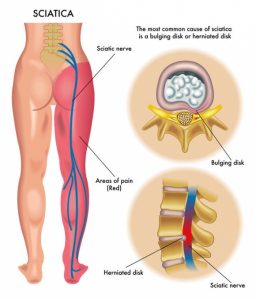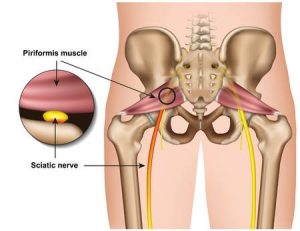Sciatica
Sciatica can be caused by several lumbar spine (low back) disorders. Sciatica is often described as mild to intense low back pain that travels into the left or right leg. It is uncommon for sciatica to affect both legs at the same time. Other terms used to describe sciatica include sciatic neuralgia or sciatic neuropathy. Sciatica can also be described as a radiculopathy. Radiculopathy is a medical term used to describe pain, numbness, tingling, and weakness in the arms or legs caused by a nerve root problem. As sciatica affects the low back and leg,it is describedas a lumbar radiculopathy.
Causes of Sciatica
Lumbar disc bulge or herniation.
The bulging and/or extrusion of the inner core of a spinal disc in the lower back can cause nerve root irritation or compression, which can be the cause of sciatica. It may be due to direct mechanical pressure on the nerve, or in the case of a disc herniation, chemicals can leak from the centre of the disc and cause chemical irritation of the nerve.
Piriformis Syndrome
Another common cause of sciatica is piriformis syndrome. Piriformis syndrome is named after the piriformis muscle. The piriformis muscle is located in the buttock and connects to the thigh bone, and assists in hip rotation. The sciatic nerve runs beneath the piriformis muscle. This muscle is susceptible to injury from a slip or fall, hip arthritis, or a difference in leg length. Such situations can cause piriformis muscle cramping and spasm to develop, pinching the sciatic nerve and causing inflammation and pain.
Degenerative disc disease of the lumbar spine
Degenerated discs in the lower back may allow excess motion in the spine and this can also lead to irritation of the nerve roots.
Rare causes of sciatica
In some rare instances, sciatica can be caused by spinal tumours or infections, which require medical treatment.
Common Symptoms of Sciatica
Usually, sciatica affects only one leg at a time and the symptoms can radiate from the lower back to the buttock, the thigh and down the leg. Sciatica may cause pain in the front, back, and/or sides of the thigh and sometimes into the lower leg and foot.
Pain.
Pain in the lower back is often the first symptom reported by people with sciatica.
Pain when lifting, straining or coughing is another common symptom.
Sciatica pain may be constant or intermittent. The pain is usually described as a deep ache, a burning sensation or a sharp, shooting pain. The pain in the leg is usually more severe than the low back pain. Leg pain commonly occurs in the calf region below the knee.
Altered sensation.
Numbness, tingling, and/or a pins-and-needles sensation may be felt down the leg.
Weakness.
Weakness may be felt in the leg and foot and a feeling of heaviness in the affected leg is common.
Diagnosis of Sciatica
Since there are several different causes of sciatica, it is important to get a professional diagnosis to determine what is causing the sciatica. Forming a diagnosis involves a thoughtful review the patient’s medical history, and a physical and neurological examination.
Diagnostic testing may include an x-ray, MRI, CT scan and/or electrodiagnostic tests (electromyography or EMG and nerve conduction velocity or NCV).
Chiropractors, physiotherapists and medical doctors are trained to provide a professional diagnosis and advise of the different treatments available to you.
Chiropractic Treatment of Sciatica
One of the goals of chiropractic is to assist the body’s potential to heal itself.
By restoring movement to restricted or fixated spinal joints, the function of the lumbar spine can be improved, which can lead to decreased pain.
In chiropractic terms, a vertebral subluxation is a term used to describe these restrictions or fixation of the spinal joints, which can negatively impact health and wellbeing.
By having the pelvic and spinal alignment and function at its optimum, the body is able to best express it’s self healing abilities
Other Treatment Modalities
A sciatica treatment plan may include several different modalities, in addition to chiropractic adjustments, including
- Ice therapy
- Ultrasound
- Tens( transcutaneous electrical nerve stimulation)
- Physiotherepy
- Exercise program
Referral
Sciatica, can be caused by other disorders that are not within the scope of chiropractic care.
If it is determined that chiropractic is not the best course of action for a your condition, sciatica or otherwise, a referral will be made to an appropriate doctor or therapist.
In some cases the chiropractor may continue to provide chiropractic care and co-manage your care with the other specialist.